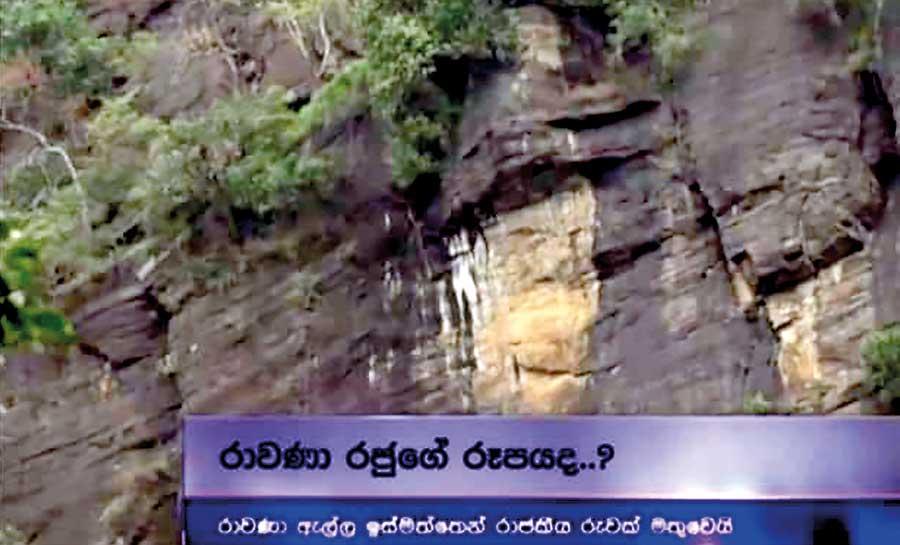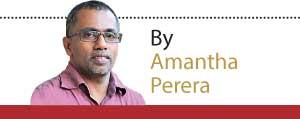14 Jul 2021 - {{hitsCtrl.values.hits}}

A media channel showing a boulder while questioning whether it is King Ravana’s face.
Yesterday morning a colleague of mine Lasantha de Silva had penned a Facebook column on the latest media gimmick.
gimmick.
The story that a TV station had floated that an image of Ravana had emerged from the side of the rock, where legend has it that the fabled flying machine was parked. Lasantha’s is an icy vocabulary, but no holds barred.
”දැන් ගලෙහි ස්වභාවික ඛාදනය නිසා මතුවූ විපරීතයක් රාවණ රුවකැයි කියා අවට ඉන්නා බඩඉරිඟු වෙළෙඳුන් ද සාක්කිකරුවන් කරමින් පචලොරියක් ටිපර් කර ඇත’”
The wit aside, Lasantha highlights an important aspect of how fakes can now be paraded as real news by dressing them as such.
"News holds the job of public information as paramount. Entertainment is there to make the people happy not informed. When we apply the same characteristics that make entertainment great to news, we have a public that is entertained and captive but uniformed"
The story has tactfully invested those who can gain from its virality in the story. Those who operate the roadside shops can benefit directly from the story if it goes viral. If virality results in more visitors to the site.
Those who compiled this news may not have thought of the planning in this manner or form. But what they have done is that they have created the appearance of a news story. You have an incident – the rock chipping off, you have the source – the area shopkeepers and now you have your news.
When there are no critical voices in a story, the reinforcement it conveys is also non-critical of the content.
The story also plays on another aspect, popular myths. These myths can get shrouded in all kinds of semi-facts and down the road no one has any idea which is which.
This may be an innocuous story. But the formula has far reaching impacts. This may bring some respite to failing viewer numbers. But it is also indicative that the gatekeepers are lax, gullible to these kind of antics or supportive of them. What is likely is that they are all of the above.
Sri Lankan media is showing signs that the lines between infotainment and reportage are blurring. The distinctions that make news different from the teledrama belt is no longer clear.
News holds the job of public information as paramount. Entertainment is there to make the people happy not informed. When we apply the same characteristics that make entertainment great to news, we have a public that is entertained and captive but uniformed.
"This may be an innocuous story. But the formula has far reaching impacts. This may bring some respite to failing viewer numbers. But it is also indicative that the gatekeepers are lax, gullible to these kind of antics or supportive of them. What is likely is that they are all of the above"
And it is an uninformed public that is most dangerous because theirs’ are decisions based on ignorance and fiction. This becomes even more of a problem, when there is no balance. That a section of media will always be swayed by the number of eyeballs on them is as old as human communication.
The danger is acute when everyone tries to be this. There is no alternative to this fake narrative. Like if there was no Lasantha writing about the faked reappearance of Ravana.
In Sri Lanka I have argued that the best option for public service media is the public-owned media. We have been programmed to refer to these as state-owned and think of them and allow them to be party-owned, depending on the party which is in power.
When two parties have tried to run the country once as we saw between 2015 and 2019, inevitably they fight like a mongoose and a cobra who met in narrow ditch. In those fights, one of the turf wars has always been for the control of the public-owned media – maintained by public money, but not for the betterment of the public.
Here is where the uniformed public plays its part.
"In Sri Lanka I have argued that the best option for public service media is the public-owned media. We have been programmed to refer to these as state-owned and think of them and allow them to be party-owned, depending on the party which is in power"
When we have stamped put critical thinking and replaced it with titillations, like the appearance of the shadow of an ancient fable on a rock, we promote and foster a nation on non-thinkers.
They do not care who owns or who operates the media that they maintain out of their own pocket.
Fake Ravanas in all their glory do feed this factory production line incessant fakes.
The writer is a journalism researcher and a writer. He can be contacted on [email protected]
08 May 2024 5 hours ago
08 May 2024 5 hours ago
08 May 2024 6 hours ago
08 May 2024 7 hours ago
08 May 2024 8 hours ago